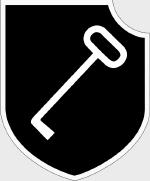Hobby Master HG4306 German Sd. Kfz. 234/3 8-Wheeled Armored Car - 1.SS Panzer Division "LSSAH", Hungary, February 1945 (1:72 Scale)
"We must do everything we can to promote anti-tank defense, and work just as hard to guarantee successful counter-attacks through the instrument of powerful tank forces of our own."
- Major-General Heinz Guderian, "Achtung Panzer!"
 On August 5th, 1940, an order was given to design an eight-wheeled armored car similar in design to the Sd. Kfz. 231. Unlike the previous design, where the armored body was bolted to the chassis, the Sd. Kfz. 234 armored hull was to serve as the chassis, thereby strengthening the overall integrity of the vehicle. Furthermore, the armored car was to have heavier armor and a 12-cylinder air-cooled diesel engine that would enable it to operate in the hot climate of North Africa as well as the cold steppes of western Russia. Two trial versions were built and an initial order was made for 500 vehicles, which was later increased to 1,500. The initial requirement was for a vehicle equipped with the 5cm KwK 39/1 gun (Sd. Kfz. 234/2). In January 1944, the order was cut to limit the Puma production to 100 vehicles so that two new variants could be created, one mounting a 2cm KwK gun and the other a more powerful 7.5cm KwK gun.
On August 5th, 1940, an order was given to design an eight-wheeled armored car similar in design to the Sd. Kfz. 231. Unlike the previous design, where the armored body was bolted to the chassis, the Sd. Kfz. 234 armored hull was to serve as the chassis, thereby strengthening the overall integrity of the vehicle. Furthermore, the armored car was to have heavier armor and a 12-cylinder air-cooled diesel engine that would enable it to operate in the hot climate of North Africa as well as the cold steppes of western Russia. Two trial versions were built and an initial order was made for 500 vehicles, which was later increased to 1,500. The initial requirement was for a vehicle equipped with the 5cm KwK 39/1 gun (Sd. Kfz. 234/2). In January 1944, the order was cut to limit the Puma production to 100 vehicles so that two new variants could be created, one mounting a 2cm KwK gun and the other a more powerful 7.5cm KwK gun.
The 234/3 variant featured one 7.5cm K51 L/24 gun in an open-topped superstructure replacing the turret. 88 were built between June and December 1944.
Pictured here is a 1:72 scale replica of a German Sd. Kfz. 234/3 8-wheeled armored car that was attached to 1.SS Panzer Division "LSSAH", then deployed to Hungary during February 1945.
Sold Out!
Dimensions:
Length: 3-1/4-inches
Width: 1-1/4-inches
Release Date: March 2014
 Historical Account: "Normandiefront" - SS-Panzer Division Leibstandarte Adolf Hitler (LAH) was formed on March 17th, 1933, by Josef "Sepp" Dietrich, Hitler's bodyguard, on the order of der Fuhrer who wanted a full-time armed force that was completely loyal to him. It was attached to Heeresgruppe Sud during the invasion of Poland and later took part in the invasion of France and the Low Countries. For the most part LAH was held in reserve although it was employed against retreating British troops trapped at Dunkirk. After the British capitulation, it was attached to XIV Armeekorps during the second and final phase of the invasion of France.
Historical Account: "Normandiefront" - SS-Panzer Division Leibstandarte Adolf Hitler (LAH) was formed on March 17th, 1933, by Josef "Sepp" Dietrich, Hitler's bodyguard, on the order of der Fuhrer who wanted a full-time armed force that was completely loyal to him. It was attached to Heeresgruppe Sud during the invasion of Poland and later took part in the invasion of France and the Low Countries. For the most part LAH was held in reserve although it was employed against retreating British troops trapped at Dunkirk. After the British capitulation, it was attached to XIV Armeekorps during the second and final phase of the invasion of France.
Following the armistice, LAH was upgraded to a brigade and began training for the planned invasion of Britain (Operation
Seelowe). When the invasion was cancelled, LAH was transferred to Romania for the Balkan invasion.
It fought its way through Yugoslavia and Greece chasing Allied troops to Kalamata, where they were evacuated by sea to Crete. LAH was attached to
Heeresgruppe Sud during the initial stages of Operation Barbarossa, seeing action at Kiev and again at the Black Sea port of Rostov. It was transferred to France for refitting in 1942 and was upgraded again, this time to a Panzergrenadier Division. It returned to the Eastern front the following year, fighting at Kharkov and then at Kursk during Operation Zitadelle. After Kursk, LAH was sent to Italy to perform anti-partisan duties but was soon returned to the Eastern front, this time as a full-fledged Panzer Division. Following the debacle at Kamenets-Podolsk, it was sent to France for rest and refit.
LAH fought in Normandy following the Allied invasion and saw action at Caen, Falaise, and Aachen as it fell back on the German frontier. It participated in the Ardennes counteroffensive (Operation "Wacht am Rhein") where it was attached to I SS Panzerkorps. Later on, LAH was sent back to the Eastern front to help break the siege of Budapest (Unternehmen Margarethe). Afterwards, it was transferred to Austria where it surrendered to American troops at war's end.


